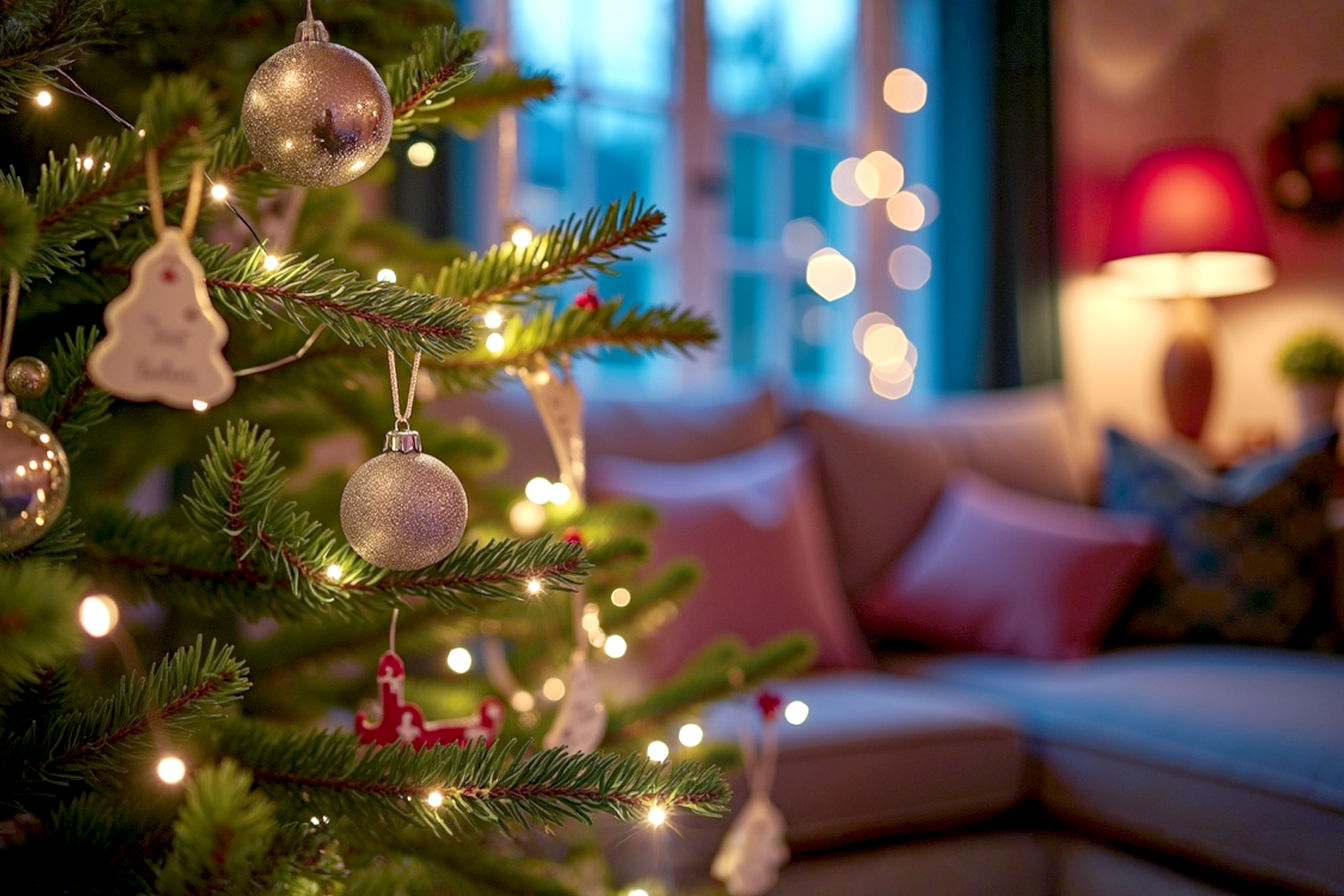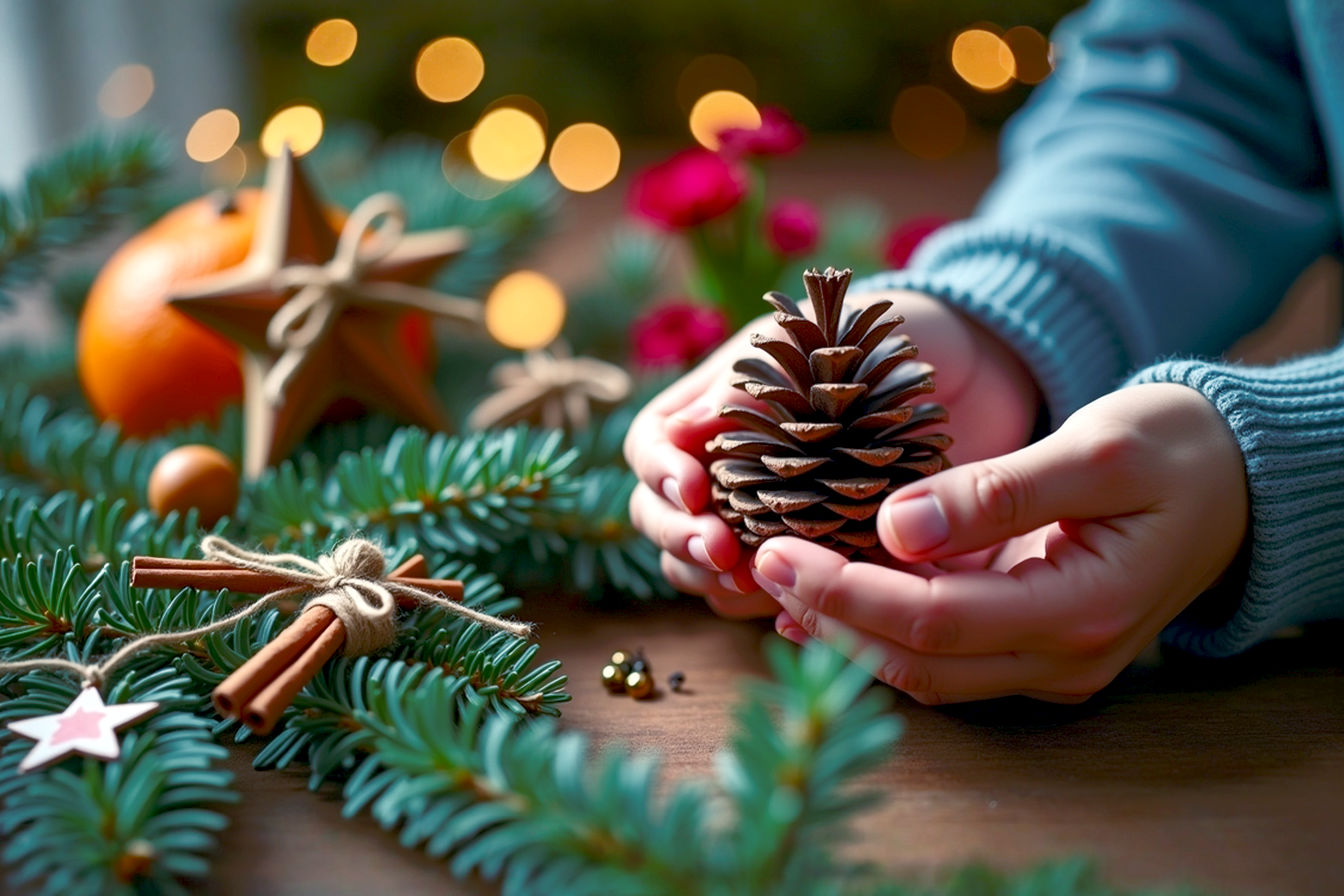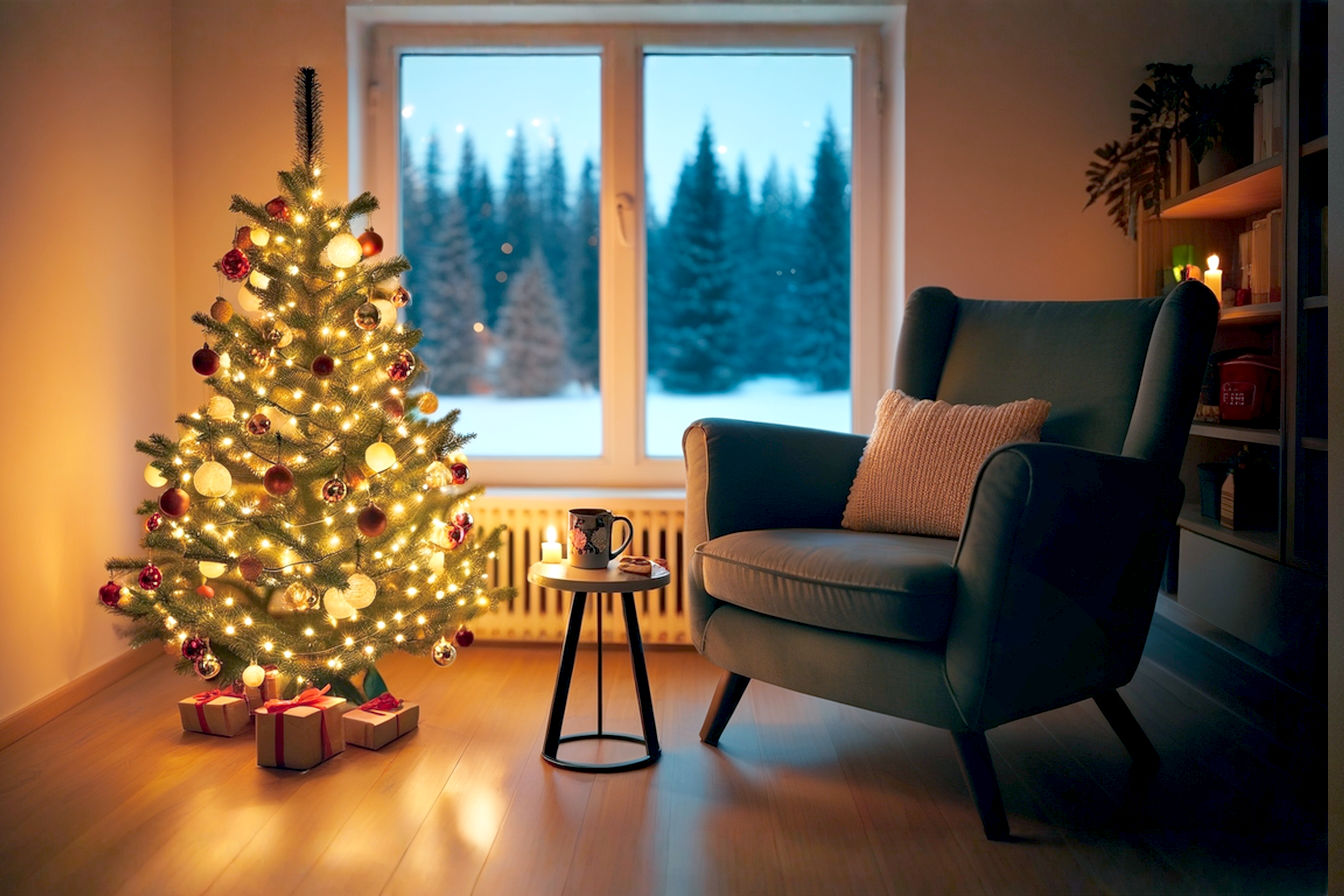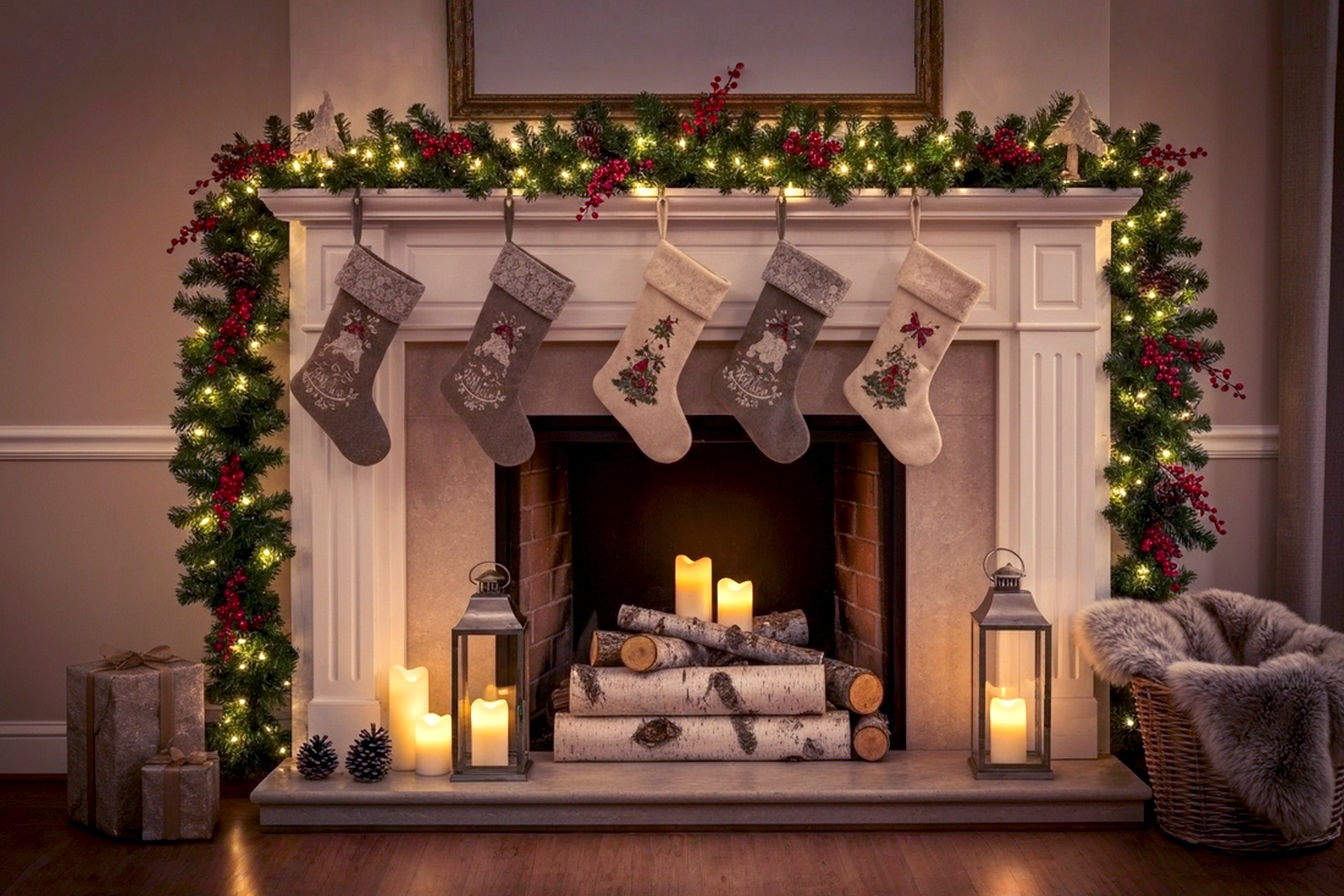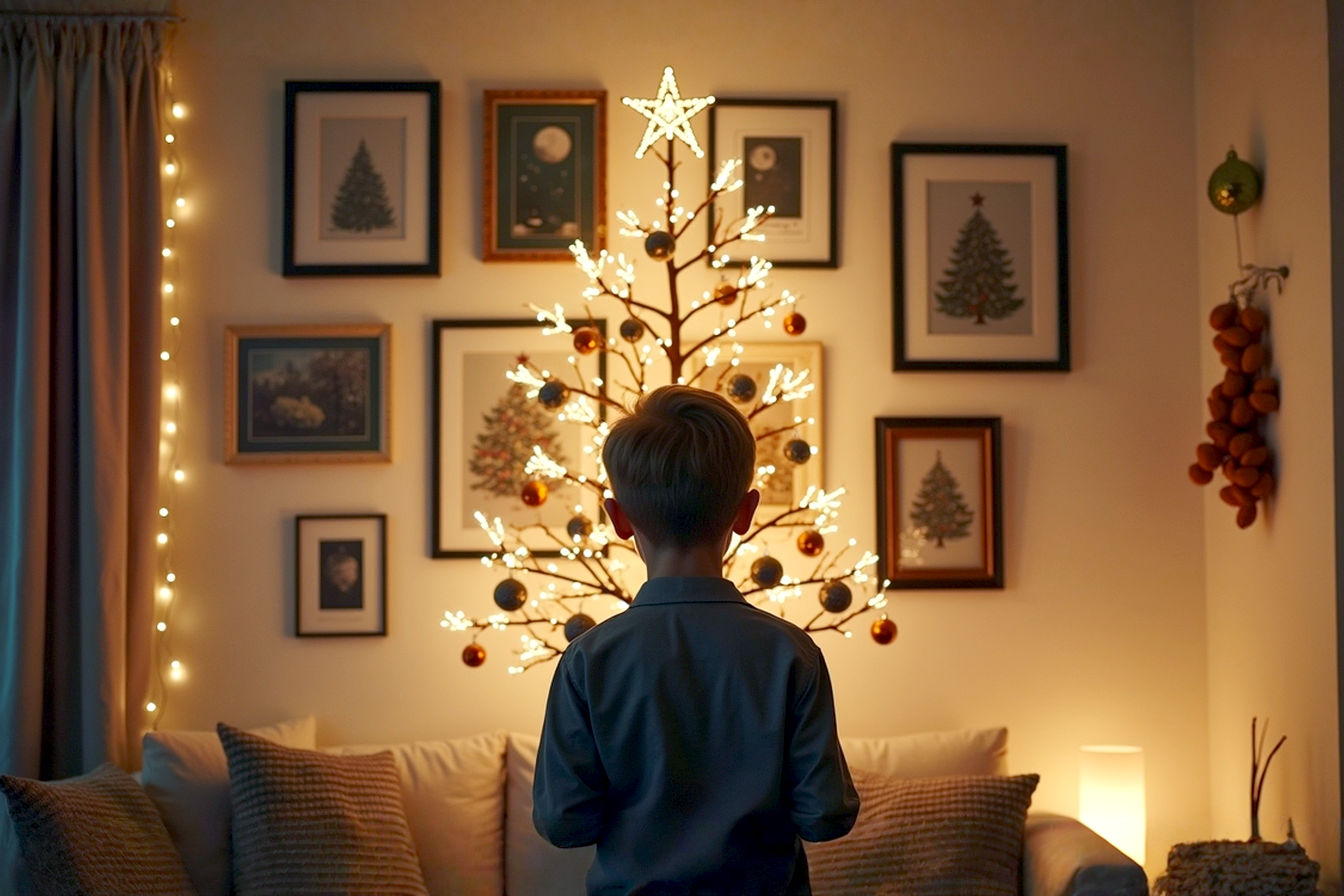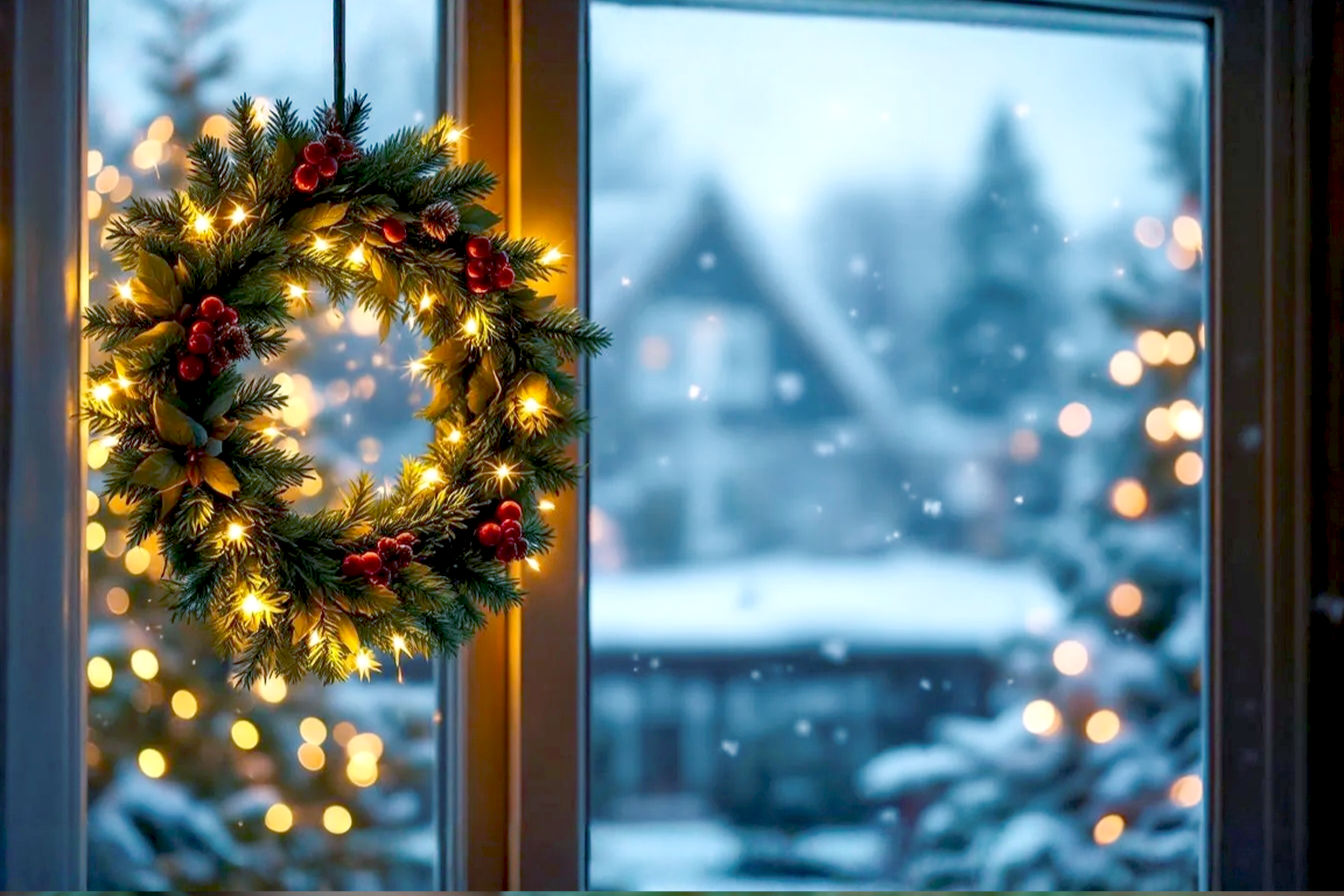This post may contain affiliate links. If you make a purchase through these links, we may earn a commission at no additional cost to you.
The holiday season brings a special kind of magic, and for many, a Christmas tree is at the heart of that festive feeling. But what if you live in a small apartment or simply want to extend that holiday cheer into your private sanctuary, the bedroom? Don’t worry, a small Christmas tree can be the perfect solution. It offers a unique blend of coziness and personal festivity without overwhelming your limited space. You can transform your bedroom into a tranquil winter wonderland, a personal escape from the busy world outside.
The Charm of a Bedroom Christmas Tree
Adding a Christmas tree to your bedroom isn’t just about extra decorations; it’s about creating a personal, intimate holiday experience. Imagine waking up to the soft glow of fairy lights and the subtle scent of pine—it’s a simple luxury that can truly enhance your holiday season. This small addition can significantly boost your mood and bring a sense of peace.
Why a Small Tree in the Bedroom?
Choosing a small tree for your bedroom makes a lot of sense, especially when space is a precious commodity. It’s not just a compromise; it’s a deliberate choice that offers several distinct advantages.
First, a small tree helps create a cozy ambiance. Large trees can feel overwhelming in a confined space, often making a room feel smaller and cluttered. A miniature tree, however, fits perfectly, adding warmth and a gentle festive glow without dominating the room. It becomes a charming accent rather than the main event, contributing to a relaxed and inviting atmosphere. Think of it as a soft, comforting presence that whispers “holiday” rather than shouts it.
Second, your bedroom is your personal sanctuary. It’s where you unwind, relax, and recharge. A small Christmas tree turns this private space into an even more special retreat. It’s a place where you can enjoy the quiet beauty of the season away from the hustle and bustle of common areas. This personal touch can make your bedroom feel more intimate and reflective, providing a peaceful backdrop for your holiday dreams. It’s a little piece of holiday magic just for you.
Finally, small trees are excellent for space optimization. In many bedrooms, floor space is limited, and every square inch counts. A compact tree allows you to embrace the holiday spirit without sacrificing valuable real estate. It can fit into corners, on top of furniture, or even be mounted on a wall. This smart use of space means you don’t have to rearrange your entire room or trip over branches just to have a tree. It’s about smart design that works with your existing layout.
Benefits of a Mini Festive Addition
Beyond just fitting into tight spots, a mini Christmas tree brings a host of benefits that make it an appealing choice for bedroom decor. These advantages often go unnoticed until you experience them firsthand.
One major benefit is enhanced mood and relaxation. The soft, twinkling lights of a small tree can be incredibly soothing. They create a gentle glow that’s perfect for winding down in the evening, perhaps while reading a book or listening to quiet music. This subtle illumination can help reduce stress and promote a sense of calm, making your bedroom an even more inviting place during the often-hectic holiday period. It’s a visual comfort that can truly lift your spirits.
Another practical advantage is low maintenance. Unlike larger trees that require significant time for setup, decorating, and takedown, a mini tree is incredibly easy to manage. You don’t need dozens of ornaments or multiple strands of lights. A few carefully chosen decorations are often enough to make it sparkle. This simplicity means you can enjoy the festive look without the usual holiday decorating stress. It’s a quick and easy way to add holiday cheer.
Lastly, mini trees offer remarkable versatility in placement. Their compact size means they aren’t confined to a single spot. You can place them on a nightstand, a dresser, a shelf, or even a desk. This flexibility allows you to experiment with different arrangements until you find the perfect spot that complements your bedroom’s layout and your personal style. You can move them around if you want a change, which isn’t easy with a large tree.
Choosing the Perfect Small Christmas Tree
Selecting the right small Christmas tree is the first crucial step in creating your festive bedroom retreat. It’s not just about picking the smallest one you find; it involves considering various types, materials, and how they will interact with your specific bedroom space.
Understanding Tree Types and Sizes
Small Christmas trees come in several forms, each designed to suit different spatial needs and aesthetic preferences. Knowing these types will help you make an informed decision.
Tabletop Trees are perhaps the most common and versatile option for bedrooms. As their name suggests, these trees are designed to sit on elevated surfaces like dressers, nightstands, or desks. They typically range from 1 to 3 feet tall (approximately 30 to 90 centimeters). Their compact size makes them ideal for adding a festive touch without taking up any precious floor space. They are often pre-decorated or come with a simple base, making setup incredibly easy.
Pencil Trees are a fantastic choice if you want a taller tree but are severely limited on width. These trees are characterized by their extremely narrow profile, often just 18 to 24 inches (45 to 60 centimeters) in diameter, even when they stand 4 to 7 feet tall (120 to 210 centimeters). Their slender shape allows them to fit into tight corners or narrow gaps between furniture where a traditional tree would never fit. Despite their height, they maintain a minimalist footprint, providing vertical festive impact without horizontal bulk.
Wall-Mounted or Half Trees are the ultimate space-saving innovation. These trees are designed to be placed flush against a wall, as they are literally “half” a tree, flat on one side. This design means they take up virtually no floor space, making them perfect for very small rooms or narrow hallways within a bedroom suite. They can range in size but are typically designed to be compact and often come with built-in hanging mechanisms. Some are even designed to look like a flat tapestry with lights.
Finally, consider whether you want a Pre-Lit vs. Unlit tree. Pre-lit trees come with lights already integrated into the branches, saving you the time and effort of stringing lights yourself. This offers immense convenience, as you just plug it in and it’s ready to glow. However, if a bulb goes out, it can be harder to replace, and you have less control over the light style. Unlit trees, on the other hand, offer complete customization. You can choose any type of lights you prefer—from classic incandescent to modern LED, in any color or pattern—and string them exactly how you like. This flexibility is great for those who enjoy a hands-on decorating experience, but it does require more effort.
Material Matters: Real vs. Artificial
The choice between a real and an artificial Christmas tree involves more than just aesthetics; it touches upon durability, maintenance, and even environmental considerations.
Artificial Trees are incredibly popular for bedroom use due to their numerous practical advantages. Their primary benefits include durability and reusability. Made from materials like PVC (polyvinyl chloride) or PE (polyethylene), artificial trees can be stored and reused year after year, making them a cost-effective long-term investment. PVC needles are typically flat, cut strips, giving a more traditional, dense look, while PE needles are molded from real tree branches, offering a more realistic, three-dimensional appearance. This reusability also means less waste annually.
Furthermore, artificial trees are hypoallergenic, which is a significant advantage for bedroom environments where allergies can be problematic. They don’t shed pollen or needles, reducing potential irritants. They also create no mess—no dropped needles to vacuum up, no sticky sap to clean. This makes them a hassle-free option for busy individuals or those who prefer a tidy space. Artificial trees also often come with fire-retardant coatings, adding a layer of safety, although it’s still crucial to use them responsibly with lights.
Real Trees, while offering undeniable charm, come with their own set of considerations. The most compelling reason to choose a real tree is its natural scent. The fresh, crisp aroma of pine or fir instantly evokes the holiday spirit, filling your bedroom with a genuine festive fragrance that artificial trees can’t replicate without external aids. This sensory experience is a major draw for many.
However, real trees require more maintenance. They need regular watering to stay fresh and safe, and they will inevitably shed needles, requiring daily cleanup. For a bedroom, this can mean more dust and potential allergens. From an environmental perspective, real trees can be sustainable if sourced from responsible tree farms that replant, as they absorb carbon dioxide while growing. However, their disposal after the holidays can contribute to landfill waste if not properly recycled or composted. The choice often boils down to prioritizing convenience and cleanliness (artificial) versus natural beauty and scent (real).
Assessing Your Bedroom’s Space
Before you even think about buying a tree, take a moment to assess the specific dimensions and layout of your bedroom. This crucial step will prevent you from buying a tree that’s too big or awkwardly placed.
Start by measuring available floor space. Identify the exact spot where you envision your tree. Use a measuring tape to determine both the width and depth of this area. Remember to account for any furniture that might be nearby, like a nightstand or dresser, and ensure there’s enough room to walk around comfortably without bumping into the tree. Even a small tree needs a bit of breathing room. For example, if you’re considering a pencil tree, measure the narrowest gap it needs to fit into.
Next, consider your ceiling height. While most small trees won’t touch the ceiling, it’s still important to ensure there’s adequate clearance, especially if you plan to add a tree topper. A tree that looks squashed against the ceiling can diminish its aesthetic appeal. Measure from the floor to the ceiling in the chosen spot. If your ceiling is particularly low, a tabletop tree might be a better choice than a tall pencil tree.
Finally, evaluate proximity to existing furniture. Think about how the tree will interact with your bed, dresser, desk, or wardrobe. Will it block a drawer from opening? Will it make it difficult to access a lamp or a power outlet? Will it obstruct a pathway? Planning for these interactions ensures that your tree enhances your bedroom’s functionality rather than hindering it. For instance, placing a tree too close to a window might block natural light, or placing it too close to a heating vent could be a fire hazard (for real trees) or cause artificial trees to warp over time. A well-placed tree integrates seamlessly into your bedroom’s existing layout.
Strategic Placement for Maximum Impact
Once you’ve chosen your perfect small Christmas tree, the next step is finding its ideal home within your bedroom. Strategic placement is key to making your mini tree shine and ensuring it enhances, rather than detracts from, your room’s overall comfort and flow.
Corner Nooks: Maximizing Unused Space
Corner nooks are often overlooked, but they are prime real estate for a small Christmas tree. Utilizing these awkward or unused spaces is a smart way to add festive decor without cluttering the main areas of your bedroom.
By placing your tree in a corner, you effectively maximize unused space. Corners are typically dead zones in a room’s layout, and a slender pencil tree or a compact tabletop tree on a small corner table can fill this void beautifully. This approach keeps your walkways clear and leaves the more central areas of your room open for daily activities. It’s an efficient use of every square foot.
Furthermore, a tree in a corner can create a focal point. Even a small tree, when properly lit and decorated, can draw the eye and become a charming centerpiece in that specific area of the room. This can be particularly effective if the corner is visible from your bed or a favorite reading chair, allowing you to enjoy its glow and beauty from a comfortable vantage point. Consider adding a small armchair or a cozy blanket nearby to create a dedicated “holiday corner” for relaxation.
Dressers and Nightstands: Elevated Elegance
Placing a small Christmas tree on a dresser or nightstand is a classic choice that offers both convenience and a touch of elevated elegance. This method lifts the tree off the floor, making it more visible and less likely to be bumped into.
When placing a tree on furniture, safety considerations are paramount. Ensure the surface is stable and can securely hold the tree’s weight. If it’s a pre-lit tree or you’re adding your own lights, make sure the electrical cord can reach an outlet safely without being stretched or creating a tripping hazard. Avoid placing the tree too close to the edge of the furniture where it could easily be knocked over. Also, be mindful of heat; while LED lights produce very little heat, traditional incandescent bulbs can get warm, so ensure adequate ventilation, especially if the tree is near fabrics or other flammable materials.
It’s also important to balance with existing decor. Your tree shouldn’t look like an afterthought. Integrate it seamlessly with the items already on your dresser or nightstand. You might need to temporarily remove some items to make space, or rearrange them to create a cohesive display. For example, if you have a stack of books, place the tree next to them. If you have a small lamp, ensure the tree doesn’t block its light. The goal is to create a harmonious vignette where the tree feels like a natural extension of your bedroom’s style.
Wall-Mounted Wonders: The Ultimate Space Saver
For bedrooms where floor space is virtually non-existent, wall-mounted trees are a revolutionary solution. They offer all the festive charm without occupying any horizontal footprint.
You can explore DIY options for wall-mounted trees. Simple yet effective designs include arranging real or artificial branches on a wall in the shape of a tree and then stringing fairy lights around them. You can also create a tree shape using only fairy lights, perhaps with a few lightweight ornaments hung within the light outline. This allows for immense creativity and can be tailored precisely to your available wall space.
Alternatively, there are pre-made wall trees available. These often come as flat, artificial tree structures designed to hang directly on a wall, sometimes even with built-in lights. They are perfect for a minimalist look and are incredibly easy to set up and take down. Some even come in the form of decorative tapestries with tree designs that light up. These are particularly good for very narrow rooms or even inside a wardrobe door if you want a hidden surprise.
Beyond the Floor: Creative Suspensions
Thinking outside the box (or off the floor) can open up even more possibilities for your small bedroom Christmas tree. Creative suspensions can add a unique, whimsical touch to your holiday decor.
One daring option is hanging from the ceiling. This requires careful planning to ensure the tree is securely suspended. You’ll need a strong ceiling hook (anchored into a joist, not just plasterboard) and sturdy fishing line or clear wire to hang a lightweight mini tree upside down or right-side up. This creates a magical, floating effect, especially enchanting when lit. It’s an excellent choice if you have high ceilings and want to draw the eye upwards, making the room feel more expansive.
Another less dramatic but equally effective idea is utilizing floating shelves. If you have existing wall shelves, a small tabletop tree can find a perfect home there. This elevates the tree, making it a prominent feature without taking up floor or furniture space. Ensure the shelf is robust enough to hold the tree’s weight and that the tree is stable on the shelf, perhaps secured with a bit of museum putty if needed, especially in earthquake-prone areas. This method works well for very small trees, typically under 2 feet tall.
Decorating Your Small Tree: A Masterclass in Miniaturization
Decorating a small Christmas tree requires a different approach than adorning a grand, full-sized one. It’s a masterclass in miniaturization, where every ornament and light counts. The goal is to enhance its charm without overwhelming its delicate scale.
The Art of Proportionate Ornaments
The biggest mistake people make with small trees is using ornaments that are too large. For a mini tree, smaller ornaments are key. Think about scale: a 6-inch (15 cm) ornament that looks tiny on a 7-foot tree will completely dominate a 2-foot tree. Look for ornaments that are typically 1 to 3 inches (2.5 to 7.5 cm) in diameter. These smaller sizes ensure that the ornaments don’t appear disproportionate to the tree’s branches and overall stature.
It’s also crucial to avoid overcrowding. While it might be tempting to hang every cute mini ornament you own, a small tree can quickly look cluttered and messy if it has too many decorations. Aim for a curated look. Select a handful of your favorite small ornaments and space them out evenly, allowing the tree’s branches and lights to still be visible. Less is often more when it comes to decorating a miniature tree.
Consider layering for depth. Even with a small tree, you can create visual interest by placing some ornaments deeper within the branches and others closer to the tips. This technique adds dimension and makes the tree appear fuller and more professionally decorated. For instance, place some simpler, smaller baubles closer to the trunk, and then hang more intricate or sparkling ornaments on the outer branches. This creates a sense of richness without adding bulk.
Lighting Up Your Cozy Corner
Lighting is arguably the most important element for a small bedroom Christmas tree, as it provides that essential cozy glow. The right lights can transform a simple tree into a magical focal point.
Micro LED Lights are hands down the best choice for small trees. These lights feature tiny, often barely visible bulbs on thin, flexible wires. Their delicate glow is perfectly suited for the smaller scale of a bedroom tree, providing illumination without overpowering the space. They are also incredibly energy-efficient, drawing very little power, which is a significant advantage for continuous use.
From a technical perspective, micro LED lights operate on a low voltage system, typically around 3-6 volts (V) per bulb, though the entire strand will convert standard household voltage (e.g., 120V in the US) down to a safe level via a transformer. Their wattage is extremely low, often less than 0.1 watts (W) per bulb, contributing to their energy efficiency. The bulb count per foot can vary, but for a dense, delicate glow, look for strands with 10-20 bulbs per foot (30-60 bulbs per meter). This higher density ensures a rich, even light distribution on a small tree.
Battery-Operated Lights offer incredible flexibility, especially for bedroom trees where power outlets might be scarce or inconveniently located. Since they don’t require a direct plug-in, you can place your tree virtually anywhere—on a high shelf, inside a decorative basket, or even in a corner without an accessible outlet. Just remember to have spare batteries on hand!
When choosing lights, consider the mood you want to set: Warm White vs. Cool White. Warm white lights emit a soft, yellowish glow, similar to traditional incandescent bulbs, creating a cozy, inviting, and nostalgic atmosphere. Cool white lights, on the other hand, have a bluish tint, offering a crisp, modern, and sometimes more vibrant look. For a bedroom, warm white is often preferred for its calming effect, but cool white can work well with specific modern or icy-themed decor.
Finally, master placement techniques. For a small tree, weaving the lights gently through the branches, starting from the inside near the trunk and working your way outwards, will create a deeper, more dimensional glow. Avoid simply wrapping them around the outside, as this can make the tree look flat. Ensure the wire is largely hidden, allowing the light to be the star.
Tinsel, Garlands, and Ribbons: Adding Texture
These elements can add texture, sparkle, and flow to your small tree, but they need to be chosen and applied carefully to avoid overwhelming its size.
For small trees, opt for thin, delicate garlands and ribbons. Thick, heavy garlands will swamp a mini tree, making it look bulky and obscuring its shape. Look for beaded garlands, fine tinsel strands, or narrow ribbons (e.g., 0.5 to 1 inch wide, or 1-2.5 cm). These lighter materials will drape gracefully and add sparkle without adding excessive volume.
Consider vertical vs. horizontal application. While larger trees often feature horizontal wrapping of garlands, for a small tree, a more vertical drape can work wonders. Let ribbons or thin garlands cascade down the branches, emphasizing the tree’s height and creating a sense of movement. A subtle, spiraling wrap can also be effective, but avoid dense, tight wraps.
Finally, a touch of subtle tinsel for sparkle can be magical. If you love the shimmer of tinsel, choose fine, individual strands rather than thick clumps. Drape a few strands delicately over the branches, allowing them to catch the light and add a gentle, ethereal sparkle. Overdoing tinsel can make a small tree look messy, so use it sparingly for maximum effect.
Toppers and Skirts: The Finishing Touches
No Christmas tree is complete without a topper and a skirt, and small trees are no exception. However, these elements also need to be scaled down appropriately.
For your topper, choose a small, lightweight topper. A heavy star or angel designed for a large tree will cause your mini tree to bend or even topple over. Look for miniature stars, delicate angels, or even a simple bow made from a thin ribbon. The topper should be proportionate to the tree’s height, typically no more than 10-15% of the tree’s total height. This ensures it crowns the tree elegantly without looking top-heavy.
For the base, consider mini tree skirts or creative alternatives. You can find small, circular tree skirts specifically designed for tabletop trees. If you can’t find one, or prefer a more unique look, get creative! A square of festive fabric, a cozy knitted scarf, or even a small decorative basket can serve as a charming base, hiding the tree stand and adding to the festive aesthetic. A small wooden crate or a decorative planter can also work wonderfully, especially for a rustic or minimalist theme.
Personalizing Your Tree: Themes and Colors
Decorating your small tree is an opportunity to express your personal style and create a unique festive statement in your bedroom. Choosing a theme or color scheme can help guide your ornament selection and create a cohesive look.
A monochromatic elegance theme involves using variations of a single color, perhaps with metallic accents. For instance, an all-white tree with silver or gold ornaments can look incredibly sophisticated and serene, perfect for a calming bedroom environment. This approach creates a clean, modern aesthetic that doesn’t feel cluttered.
For a warm and inviting feel, consider a rustic charm theme. This might involve natural elements like small pinecones, dried orange slices, miniature wooden ornaments, or burlap ribbons. Earthy tones, browns, deep reds, and forest greens would dominate the color palette, creating a cozy, cabin-like atmosphere perfect for a bedroom.
If your bedroom decor is more playful, a whimsical and playful theme could be ideal. Think bright, cheerful colors, quirky animal ornaments, or miniature candy canes. This approach allows for a fun, lighthearted display that brings a smile to your face every time you see it. It’s about embracing joy and a bit of childlike wonder.
Finally, don’t forget the power of DIY ornaments for a personal touch. Handmade ornaments add character and sentimentality to your tree. You could craft small paper stars, tiny felt shapes, or even bake and decorate miniature gingerbread cookies to hang. These personal touches make your tree truly unique and reflect your personality, turning it into a cherished part of your holiday decor.
Integrating Your Tree with Bedroom Decor
A small Christmas tree shouldn’t stand alone as an isolated festive element. To truly elevate your bedroom’s holiday spirit, you need to integrate the tree seamlessly with your existing decor. This creates a cohesive, immersive festive experience.
Harmonizing Color Palettes
One of the most effective ways to integrate your tree is by harmonizing color palettes. This means ensuring the colors of your tree’s decorations complement or match the existing colors in your bedroom.
If your bedroom already has a strong color scheme, consider matching existing bedroom colors. For example, if your room is decorated in cool blues and grays, opt for silver, white, or icy blue ornaments and lights. If your room features warm neutrals or earthy tones, gold, cream, and deep red ornaments would be a perfect fit. This creates a sense of continuity and makes the tree feel like a natural extension of your room.
Alternatively, you can introduce complementary accents. These are colors that sit opposite your main bedroom colors on the color wheel, creating a vibrant yet balanced contrast. For instance, if your room is predominantly green, a tree with red accents would pop beautifully. If your room is purple, gold or yellow ornaments could provide a lovely contrast. This approach adds visual interest and a festive punch without clashing.
You can also aim to create a festive contrast that still feels intentional. For example, a minimalist white bedroom could have a tree with classic red and green decorations, providing a traditional holiday feel against a modern backdrop. The key is to choose colors that look good together, even if they’re not an exact match, ensuring they contribute to the overall aesthetic you’re aiming for.
Extending the Festive Feel: Beyond the Tree
To make your bedroom truly feel like a holiday haven, extend the festive touches beyond just the Christmas tree. These small additions can amplify the cozy atmosphere.
Fairy lights are incredibly versatile and can be used in many ways beyond the tree. Drape them along your headboard, weave them through sheer curtains, or string them around a mirror. The soft glow adds a magical touch and enhances the overall ambiance, making the entire room feel warm and inviting. Look for battery-operated strands for easy placement without needing outlets.
Swap out your everyday bedding for festive throw pillows and blankets. A plush blanket in a holiday color like deep red, forest green, or snowy white, perhaps with a subtle pattern, can instantly make your bed feel more inviting. Add a few throw pillows with holiday motifs—a snowflake, a reindeer, or simply a cozy texture like faux fur—to complete the look. These soft furnishings add warmth and visual interest.
Introduce scented candles or diffusers with holiday fragrances. Scents like pine, cinnamon, gingerbread, or cranberry can significantly enhance the festive mood. The olfactory experience is powerful and can evoke strong holiday memories and feelings of comfort. Always use candles safely, keeping them away from flammable materials and never leaving them unattended, especially in a bedroom. Diffusers offer a flameless alternative for continuous scent.
Finally, incorporate small festive figurines or artwork. A miniature Santa, a tiny reindeer, a snow globe, or a framed print of a winter scene can be placed on a nightstand, dresser, or shelf. These subtle decorative elements reinforce the holiday theme without overwhelming the space, adding charming details that contribute to the overall festive narrative of your bedroom.
Creating a Cohesive Look
The secret to a beautifully decorated small space is cohesion. Every element should feel like it belongs, contributing to a unified theme rather than looking like a collection of random decorations.
Remember that less is often more, especially in a small bedroom. Over-decorating can make the room feel cluttered and busy, defeating the purpose of a relaxing sanctuary. Focus on quality over quantity. A few well-chosen, impactful decorations will have a greater effect than dozens of mismatched items. This minimalist approach can still be incredibly festive and elegant.
Focus on key elements that truly define your chosen theme or color palette. Instead of trying to incorporate every holiday item you own, select a few standout pieces—perhaps a beautiful tree, a festive throw, and a scented candle—and let them shine. These key elements will carry the decorative weight and establish the holiday mood.
Crucially, always ensure you’re maintaining bedroom functionality. Your holiday decor should never impede the practical use of your bedroom. Make sure you can still easily access drawers, open doors, walk around your bed, and use your lights. A beautiful tree that blocks your closet door or makes it hard to get into bed isn’t practical. The goal is to enhance your space, not hinder it. A functional and beautiful bedroom is the ultimate win.
Practical Tips for Small Space Decorating
Decorating a small bedroom for Christmas involves more than just aesthetics; it also requires practical considerations to ensure safety, ease of use, and efficient storage. These tips will help you manage your festive decor effectively.
Safety First: Electrical and Stability Concerns
When adding electrical lights and a tree to your bedroom, safety should always be your top priority.
Always begin by checking light cords. Before plugging in any string of lights, inspect the entire cord for frayed wires, cracked insulation, or loose connections. Damaged cords can pose a significant fire hazard. If you find any damage, replace the lights immediately; don’t try to repair them. Ensure that all lights are certified for indoor use.
Next, focus on securing the tree base. Whether it’s a tabletop tree or a floor-standing pencil tree, ensure its base is stable and won’t easily tip over. For tabletop trees, place them on a flat, sturdy surface away from the edge. If you have pets or small children, consider using museum putty or a similar adhesive to temporarily secure the base to the furniture. For floor trees, ensure the stand is wide and stable, and if it feels wobbly, consider placing weights on the base or securing it to a wall with a clear fishing line.
Finally, keep flammable materials away from lights and any heat sources. While modern LED lights produce very little heat, it’s still good practice to keep curtains, bedding, paper decorations, and other easily flammable items a safe distance from your tree and lights. Never leave lights on when you leave the room or go to sleep. Consider using a timer for your lights to ensure they turn off automatically.
Storage Solutions for Off-Season
Once the holidays are over, efficient storage is crucial for small spaces. You want to protect your decorations and keep your bedroom clutter-free.
Invest in compact storage bags or bins specifically designed for small artificial trees and ornaments. Many mini trees come with their own storage boxes, which are ideal. For ornaments, use clear plastic bins with dividers to keep them organized and protected from damage. Label everything clearly so you can easily find it next year.
If you no longer have the original packaging for your tree, try to find a box that closely matches its size. Original packaging is often designed to fit the tree perfectly, making it the most efficient storage solution. For lights, carefully wrap them around a piece of cardboard or a dedicated light reel to prevent tangling and damage.
Utilize often-overlooked storage areas like under-bed or closet space. Slim, flat storage containers can slide neatly under your bed, keeping decorations out of sight but easily accessible. If your closet has high shelves or unused corners, these can be perfect spots for compact bins of holiday decor. The goal is to store items in a way that doesn’t take up valuable everyday living space.
Budget-Friendly Decorating
Decorating your small bedroom for Christmas doesn’t have to break the bank. There are many ways to create a festive look on a budget.
Embrace DIY ornaments. Crafting your own decorations can be incredibly cost-effective and adds a unique, personal touch to your tree. Think about simple materials like paper, felt, pinecones collected from outdoors, dried orange slices, or even small cookies. These handmade items often have more charm than store-bought ones.
Explore dollar store finds or discount retailers. These stores often have a surprising selection of small, inexpensive ornaments, ribbons, and fairy lights. While they might not be heirloom quality, they can provide a pop of color and sparkle for a very low cost. Just be sure to check the quality of electrical items like lights before purchasing.
Finally, repurposing existing items is a great way to save money and be creative. That old scarf can become a tree skirt, spare buttons can be glued onto felt shapes for ornaments, or small toys can be given a temporary holiday twist with a bit of glitter. Look around your home for items that can be given a temporary holiday twist, adding to your decor without buying anything new.
Maintenance and Care for Your Mini Tree
Proper maintenance ensures your tree looks its best throughout the season and lasts for many years to come.
For artificial trees, basic dusting is usually all that’s required. Over time, dust can accumulate on the branches and needles. Use a soft cloth, a feather duster, or even a can of compressed air to gently remove dust, keeping your tree looking fresh and vibrant. If it’s stored properly, it should require minimal fuss each year.
If you opt for a real tree, regular watering is essential to keep it fresh, green, and minimize needle drop. Even a small real tree needs a consistent water supply. Check the water level in the stand daily and refill it as needed. A well-hydrated tree is also less of a fire hazard.
For all types of trees, it’s wise to check lights annually. Before you put up your tree each year, plug in your lights and inspect them. Replace any burnt-out bulbs (if they are replaceable) and check for any damaged wires. This pre-season check saves you frustration later and ensures your tree will shine brightly from the moment it’s set up.
Conclusion: Embracing the Small Tree Magic
Decorating a small Christmas tree in your bedroom is a delightful way to infuse your personal space with holiday cheer. It’s not about grand gestures but about creating a cozy, intimate, and truly personal festive sanctuary. From selecting the perfect miniature tree to strategically placing it and adorning it with proportionate ornaments and delicate lights, every step contributes to a magical atmosphere.
We’ve explored how understanding different tree types—tabletop, pencil, and wall-mounted—can help you maximize your limited space, and how choosing between artificial and real trees impacts maintenance and ambiance. Strategic placement in corner nooks, on dressers, or even suspended from the ceiling can transform unused areas into charming festive displays. When it comes to decorating, the art of miniaturization is key: small ornaments, micro LED lights, and delicate garlands ensure your tree sparkles without being overwhelmed. Finally, integrating your tree with existing bedroom decor through harmonious color palettes and extending festive touches like fairy lights and cozy textiles creates a cohesive, inviting holiday haven.
Embrace the simplicity and charm of a small tree. It proves that you don’t need a sprawling living room or a massive tree to experience the full joy of the holiday season. Your bedroom, with its perfectly decorated mini Christmas tree, can become your favorite spot to unwind, reflect, and soak in the quiet magic of winter. So go ahead, create your own cozy holiday bedroom—it’s a little piece of festive enchantment just for you.

